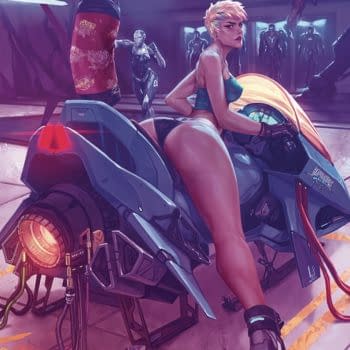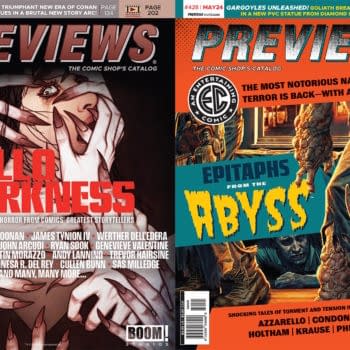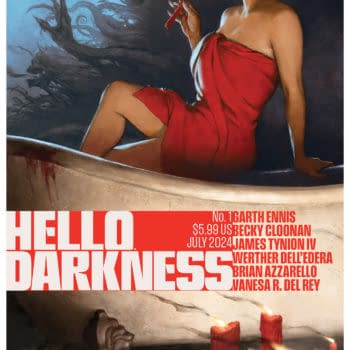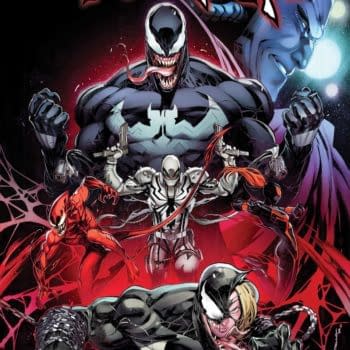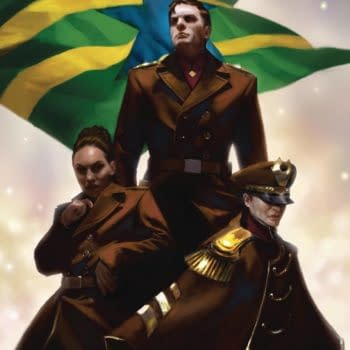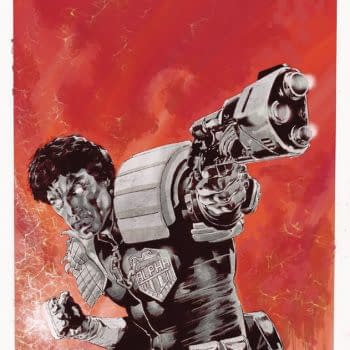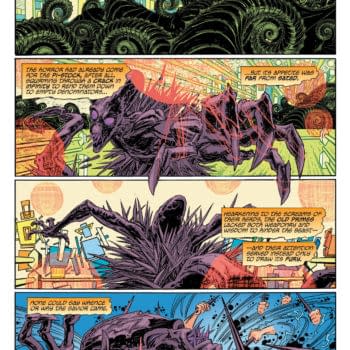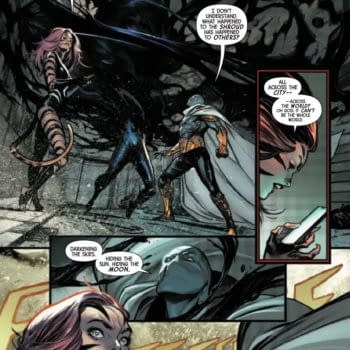Posted in: Comics, san diego comic con | Tagged: comic con, Comics, entertainment, san diego, san diego comic con, sdcc, sdcc '16, sdcc16
"I Am Older Than You, Blacker Than You" – When Priest Won His Inkpot At San Diego Comic-Con

Christopher James Priest received the Inkpot award at the start of his spotlight panel at Comic Con. "Never won anything." quipped Priest.
The End.
Okay. There was more.
Let's go to the part after the Inkpot awarding, where Priest says the first line of the panel properly.
"Hi, I'm Christopher Priest, I am older than you, blacker than you."
One fan called him on that, and Priest acknowledged that there may in fact be a man older than him and at least as black as him in the room.
Now comes the history lesson. He was the first African-American editor at Marvel. He got hired at a young age as Larry Hama's assistant on Crazy Magazine at Marvel in 1978. In 1990 he became the first African-American editor at DC, where he was producing Spelljammer and other comics based on TSR Roleplaying games. (At least one guy cheered for these.)
Over the years, he's written just about every major character. From a Falcon miniseries, to Power Man and Iron Fist, Conan the Barbarian (Seriously, he did a great job on those.) He wrote the Spider-Man vs Wolverine one-shot which sold incredibly, phenomenally well, but Marvel never asked for a sequel or for anything else in that vein. At DC he co-created the modern version of the Ray. At some point there was a scrawny kid in the lobby who came looking for work, and the artist working on Spelljammer on the time just quit over "a bigger dressing room or something." There was an artist looking for work, art needing to be drawn, and that's how Joe Quesada got hired. Priest acknowledged that he's helped folks like Peter David, Kyle Baker, Marc Silvestri and Mark Beachum get hired, and now they are all more powerful in the industry than he is.
He's been in the business for 38 years, though in the past decade a few things happened. The team book he was doing at Marvel, the Crew, was canceled before issue 1. Marvel decided to package that book as part of a line with some other unrelated books, which were ill received, so before the first issue of the Crew came out, the entire line had been canceled. He dealt with that. They gave him Captain America and the Falcon, a series set in standard continuity while the main Captain America book was a Marvel Knights title. For a year or so it went well. Then they were going to end the Marvel Knights book and bring back a proper Captain America title. Instead of moving him from the side book to the main, they hired someone Priest had never heard of, some young guy named Ed Brubaker.
"He's a great writer but… THAT WAS MY BOOK DAMMIT!"
The consolation prize was going to be a Falcon solo, but Priest started off as just a comics writer, and somehow became "the black writer", and being offered the Falcon didn't feel right.
"There were variables in that decision that editorial was not aware of. I'm not saying it was a racist choice. It felt like a demotion to me."
Over at DC, Paul Kupperberg offered him a chance to write a series of novels based on Green Lantern. He outlined the trilogy and wrote the final volume. It was both freeing, as DC didn't care at all what happened, so he could use Batman or Aquaman or whoever the hell he wanted without anyone telling him not to, but at the same time, it paid almost nothing. There was an audio book, more of a play with a full cast recording it that is worth checking out.
So Priest was tired of the comic book thing, went out looking for opportunities, went into Pastoring. (You know, in a church.) And every 18 months or so, DC or Marvel would contact him saying "I want to bring back All-Negro Comics and I want you to write it! You can write Black Goliath or Black Lightning, with or without the wig!" (Folks, text doesn't convey nuance, but trust me when I say that Priest was exaggerating, but only slightly here.)
"When did I become a Black writer? I'm proud of being African-American, but I built my career on writing Spider-Man and Green Lantern, Thor and the Hulk. When did I become only eligible to write black characters?"
"Finally, I got offered Firestorm."
This is where the audience, aware of Jason Rusch, and that he's black, laughs because we see where this is going. Priest continued to explain that he figured he could do something with the guy with BBQ hair. It was a productive discussion, things were going well, until they sent him reference material and Priest went "He's black? When did he become black?!" They thought he knew, it was awkward.
That was about three years ago. About four months ago, a group editor at DC e-mailed him, asking about Deathstroke. "It took me a while to remember, he's the guy who fights the Teen Titans. Wears chainmail. Half blind. Dresses in orange. A villain. That was an interesting challenge."
DC explained the Rebirth idea, as an evolution or course correction from the New 52. "Fine. What's the new 52?" He's still catching up, and some of the things that happened while he's been away from comics seem ludicrous. He read the New 52 Deathstroke series, "With all respect, I am not interested in doing that. If I can go behind the mask, be introspective, get inside the mind of a killer, that's something that I would be open to. DC said yes. I got 90% of what I pushed for. DC is wrong about the other 10 %."
He didn't recognize the character from the current series, and asked if he could go back to Marv Wolfman and George Perez's version from the New Teen Titans, made to fit into 2016. "Marv Wolfman is one of my first bosses, I interned for him on Tomb of Dracula. And Perez, the guy we called George Payraise, is the sweetest guy to walk the Earth. Can I write that guy?" He's taken the character away from being a hulking supersolider, more back to being an assassin. They don't go in with a full bandolier, they're very quiet. Come in, slit your throat, leave. Its part of the rules.
You can read his whole manifesto about the character at Christopherpriest.com/
Somewhat like Black Panther, Deathstroke's greatest power is his intellect, which is traditionally underemphasized. To make the book more intimate, Priest is moving away from 1st Person, so that any point, the other characters are wondering what he is up to, and so are the readers. "I write him as Batman's equal in every sense of the word." This interpretation of Deathstroke is loaded. He'll dress up in full gear when going into a warzone or when it's appropriate, but he's not going to wear a hardware store on his back all of the time.
"Marvel is let's take chances. DC is we have rules and regulations."
Priest has gotten frustrated dealing with DC at times. He'd say something like "I want Deathstroke to kill that cat." The respond he'd get is "You can't, he's never done that before," which doesn't actually explain why or give a proper solution. The Ravager, Rose Wilson. Why is she called that? She's named after her dead brother whom she never met? Why would she go by that name? Batman, who shows up in issue 5, confronts Rose as she is driving the Batmobile, explaining that Batman is not his name, it is what other people call him. So what is her name?
"This is me kicking DC in the shin. We have to write this better. The audience is better. We want people to be properly motivated."
Priest feels like he's driving people at DC insane, making them wonder why they even bothered to ask him back. He thinks that people familiar with his work will like what he's doing. Deathstroke is a villain. To those people who expect that just because his name is on the cover that he'll be a good guy, somehow act heroically by accident, like a Clint Eastwood action hero, or that they'll just say he's a "mercenary" or a "Soldier of Fortune" that they are going to be disappointed because Deathstroke is a villain. "He is a son of a bitch, not a nice guy." On page one of issue one, Slade is being a total dick to his kids, that's the kind of character he is. He loves his children, just that he's the worst dad ever. But he's very good at being an assassin.
Priest feels that villains are often short changed, as heroes get three dimensions, while the supporting cast are lucky to get two. So he's planning on explaining more about him. "Why isn't everyone chasing him down 24/7?" The book requires an answer to that question, of why Superman can come home and kiss Lois or whatever he does these days and allow this maniac to run around in an orange suit. Priest elaborated that it was about the idea of Justice and Villainy. Superman could kill him. Batman could too. But that wouldn't be justice. Just like OJ Simpson, Slade Wilson is very rich and has a lot of lawyers, is very good about not leaving evidence that concretely connects Slade Wilson and Deathstroke as one and the same, even though it is an open secret in the superhero community.
Slade Wilson is an emotional junkie, addicted to the action. He CAN'T give it up. He loves his family, but he can't show it. You can hug hum, but he will never hug you. "He's House MD with a machine gun."
The book is the Sopranos with Supervillains. Trying to make that dysfunctional family work, when the father is busy assassinating people. There are two art teams, working on two of the plot threads. Carol Pagulayan and inker Jason Paz are doing stories focusing on his ex-wife Adelaide and son Jericho, while Joe Bennett (formerly worked with Priest on The Crew), and Mark Morales do stories focusing on his relationship with Rose.
Then it became Q&A Time.
A fan gushed about Xero, the creator-owned series he did at DC in the 90s, and asked for the inspiration. Priest first explained that the concept is "What if Denzel Washington and Kevin Costner are in the same movie, playing the same character?" You have a Charles Barkley NBA star-type character, who secretly is an assassin, a covert operative named Xero whose full face mask makes him look like a blonde haired blue eyed guy. No one would ever suspect it. The book evolved out of ideas he had as a kid, sharing short stories with his friends, (who were his inspiration for various characters) with the then-modern technology of carbon paper. Then-DC Publisher Paul Levitz asked him to come up with something new and original, but the editors apparently didn't get that memo.
Peter S. Svensson's Pal Tom Galloway, who will be hosting the Pro/Fan Comics Trivia Match on Sunday, asked "What is a villain to you?"
Priest expressed his idea that a villain is someone who isn't mentally ill, but consciously does something evil. Most superhero rogues gallery by his definition aren't villains. "Joker isn't a villain. He's psychotic. Slade isn't mentally ill, he's made a decision of how to live his life." He continued explaining Slade's backstory, that when he was in the army he was more like Captain America. He did wetwork missions, but it wasn't necessarily evil. It was when his son was kidnapped that things went wrong. He did a mission, pissed off some foreign colonel, who hired mercenaries that were supposed to kill Slade, but kidnapped his son to use them as a target. During this debacle, his son's throat is cut. That's when he becomes Deathstroke in this not revised, but more idealist revisionist history. He went from nearly heroic, to a covert operative who was at least not evil, but crossed that line when his family fell apart, he got divorced after his wife shot his eye out.
"I know you don't want to be 'the black writer', but do you actively try to leave black characters better than when you found them?"
"My approach to writing is that every version is valid." explained Priest, who stated that when writing Black Panther he went out of his way to honor the previous works of Don McGregor, and to "not invalidate the Kirby Panther that was ridiculous. Everything that happened happened." He will continue that philosophy with Deathstroke.
With Steel, Louise Simonson (formerly Louise Jones before marrying Walt Simonson) is a wonderful, talented woman and a good friend of his. He would never say that his version was better. However… when writing John Henry Irons, he was writing him like he was Dwayne McDuffie. And without directly stating it to the artists, that was how the character started to be drawn. As Dwayne McDuffie. Priest's niece Candice was the model for Natasha Irons. The idea that Steel was raising a teenager, working with crazy people, and somehow dealing with a guy named Doctor Villain, who Priest admitted will be coming back in Deathstroke.
When working on Luke Cage, staffers at Marvel confronted him, stating that he didn't write black characters well, since there wasn't enough jive in the dialogue. So he wrote a scene where Luke Cage screams and yells and does the whole "CHRISTMAS!" thing, and gets ignored. Luke then has a thought balloon of "Well, okay. I tried my loud angry negro routine." The reaction that got was… yeah. You probably can figure it out.
The idea of Code Switching was brought up, that when with different people you speak differently. "For a person of color, in an environment like Marvel, being able to properly articulate the English language is a job skill." Back in the 80s, Marvel was like Mad Men. In fact, the offices they had in season one were close enough to the actual ones Marvel had that it freaked him out. So back then, at one point he was alone in an elevator with a young white girl, who was visibly uncomfortable, until he made polite small talk. Then she relaxed because he could go "He's one of the good ones. He's okay."
Reginald Hudlin, when hearing that story asked why was it his responsibility to make her feel less uncomfortable.
He used to skip to work at Marvel. He was 17 years old, and skipped down the street to get there. "The part of me that is relatively male said STOP SKIPPING NOW." He was so thrilled to be there. He gave this fatherly advice to us all. "Figure out what you want, find a way to get paid to do it. Keep your eye on what you want. Don't get distracted by small stuff."
Priest admitted that it's hard to tell how much trouble he had to deal with was because of racism, and how much was about him being a jerk back then. What made him leave Marvel was Spider-Man getting married. He was the youngest and the blackest Spider-Man editor, and he felt that getting Spider-Man married was dumb. He was a character that young people related to, getting married would ruin that. "Spider-Man gets married over my dead body." Within a few weeks he was fired. He did get the offer to write the honeymoon issue, and took it. "Gosh darn it."
"About Milestone…"
"I am Pete Best." explained Priest. He brought the ideas that would become Icon and Rocket to their earliest meetings, and since he was good at naming characters, did things like say the kid with electrical powers should be called Static. Denys Cowan was doing character sketches on the fly, Dwayne McDuffie was in the middle of a custody battle so he was relatively distracted, so Priest wrote up the first proposal in Jim Chadwick's office at DC. What happened was that as it continued, there was a conflict between him and one of the creators, so he stepped away and became the Pete Best of Milestone.
He is working with the to-be relaunched Milestone, working with Jim Lee and Reginald Hudlin on the creative side, and in fact has a meeting with Hudlin on Sunday. On the business side of the new Milestone… he has no clue.
Hannibal Tabu asked if Priest made the Milestone logo, and yes. He did.
Another fan asked about how as a writer you get into a dark place to write material that needs it. Priest explained that getting to that dark place is easy, take what happens to you, your inner demons. The example he gave was the one and only Ray Annual, where the plot of the story is a Jumbo Jet is crashing, and the Ray wants to save it. He's trying to save it. Superman does it, so it can be done! He does everything he can to keep it from crashing. It crashes anyways. That story was about his divorce, how hard we try, and try to make things work. "We're couching it in metaphor, but we're working out stuff in our head. When you get it, and the magic is happening, write like hell, because when it stops flowing…" He then indicated the difficulties of writing when the words aren't coming.
The next fan asked about Josiah, the black Captain America from The Crew, and would have happened had the series continued. Priest offered to e-mail the guy a summary once he reviewed his notes for the character who at the time, as a Muslim American was so controversial, but today, Ms. Marvel is a big hit for Marvel.
His greatest unfulfilled dream was writing Batman for DC, and Iron Man for Marvel. He was actually this close to getting hired as the Batman writer after doing a story that got adapted as part of Batman Begins, (Batman's journey to Tibet) and everyone assumed he'd be taking over the book, even to the point of people telling him that he was behind schedule on it, but just before Denny O'Neil was going to offer the position to him, Marv Wolfman walked into his office and asked for the gig, and well Wolfman was a name writer and Priest was not. He smiled though, because now he's writing a book that used to belong to Wolfman. (Deathstroke.)
There will be humor in Deathstroke. There's a bit in the Rebirth one-shot that isn't funny, but will retroactively become so once issue 1 comes out. "It's hard to explain." He continued to explain that Deathstroke is never funny, but as "I am a complete idiot, humor will visit Deathstroke. And people mock Slade. Wintergreen mocks him."
Priest would love to work again with Chriscross, who he says is one of the most brilliant storytellers. "I met Neal Adams today. I've worked with Larry Hama, one of his acolytes, but I'd never met the man himself. It would be great to do a story with him." He also mentioned that John Romita Jr operated the Xerox machine at the age of 19 when he was at Marvel.
It took 18 months for him to do Green Lantern: Emerald Dawn because the editor was used to working with Keith Giffen, and ended up having him rewrite the script 137 times. Eventually he realized that this wasn't a job, just the same script over and over again, and just told the editor to call up Keith and have him take over.
A fan asked a question about a recent trend of turning villains to hero as the last question. Priest commented that he is so out of the loop regarding modern comics that it's laughable. He tried using an example of that clown girl character, in the suicide squad movie? "Apparently she's popular?" He feels that there are just often trends, like why are vampires popular? He does feel, as an ordained pastor, that DC or Marvel should be trying to reach out to the Christian market, a multi billion dollar market. He doesn't mean something like Superman fights Jesus, but something akin to the TV series Joan of Arcadia. That show hit the sweet spot, talking about spirituality without being pushy in one direction or another. He commented that churches preach against the ultra-violence and sexuality they see in comics. So of course, he's writing Deathstroke.
And that was it, the panel ended. It was a good one. I couldn't give the hilarity and the energy of it justice. But give Deathstroke a shot. I will.
Peter S. Svensson continues to write for Bleeding Cool. He will be competing in the Pro/Fan Comics Trivia Match on Sunday. Please cheer him on. Next month, he'll be organizing the official Power Morphicon, the Power Rangers convention in Pasadena, CA. He's pretty geeky that way.






